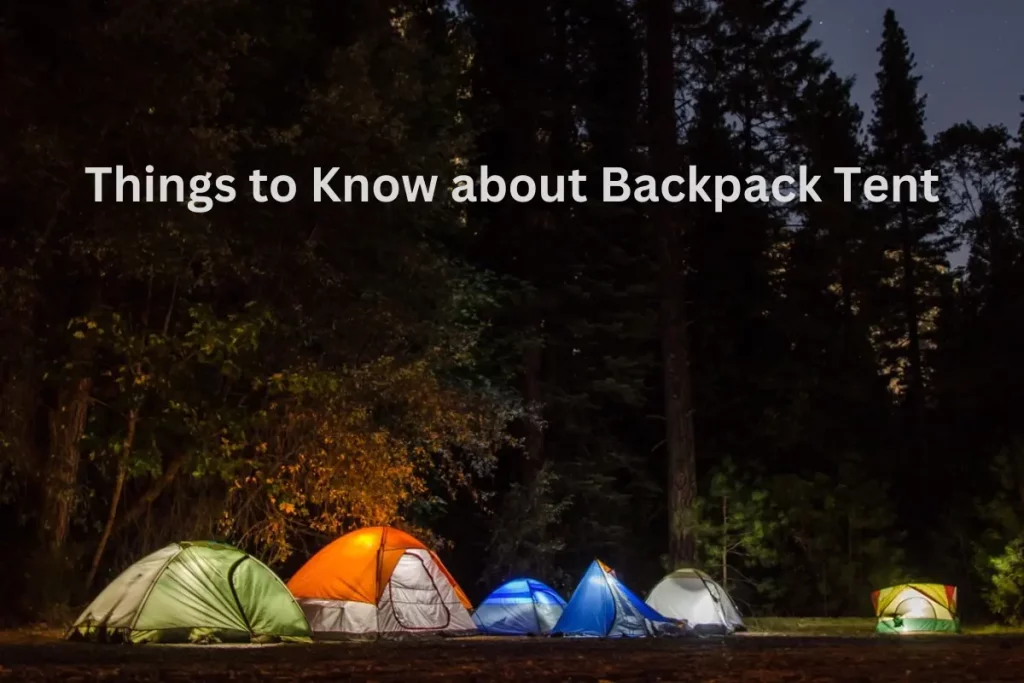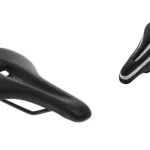A backpack tent, also known as a backpacking tent, is a type of tent that is designed to be lightweight and compact for easy transport on hiking and camping trips. As the name suggests, backpack tents are designed to be carried in a backpack, making them ideal for backcountry camping where weight and space are important considerations.
Backpack tents are typically made from lightweight materials such as nylon or polyester, and they are designed to be easy to set up and take down. They usually come with lightweight tent poles that can be broken down into smaller sections for easy packing, and they may also come with lightweight stakes and guy lines to help anchor the tent in place.
Backpack tents come in a variety of sizes and styles, from one-person tents that are barely large enough to accommodate a person and their gear, to larger tents that can accommodate two or more people. Some backpack tents are designed for use in specific conditions, such as three-season tents that are designed for use in spring, summer, and fall, or four-season tents that are designed for use in winter conditions.
Overall, backpack tents are a great option for anyone who wants to explore the backcountry and enjoy the great outdoors without being weighed down by heavy camping gear.
Material to Use for Making Backpack Tent
Backpack tents are typically made of lightweight and durable materials that are designed to withstand the rigors of outdoor use while keeping the weight of the tent to a minimum. Here are some common materials that are used in the construction of backpacking tents:
- Nylon: This is one of the most common materials used in backpacking tents due to its strength, durability, and lightweight. Nylon is also water-resistant, which makes it a good choice for tents that may be used in rainy or damp conditions.
- Polyester: Polyester is another common material used in backpacking tents. It is similar to nylon in terms of strength and durability but is often more resistant to UV rays and abrasion.
- Cuben Fiber: This is a newer material that is becoming increasingly popular in the construction of backpacking tents. It is incredibly lightweight and strong, but also quite expensive.
- Mesh: Most backpacking tents also feature mesh panels to improve ventilation and reduce condensation. Mesh is typically made of nylon or polyester and is very lightweight.
- Aluminum or carbon fiber tent poles: These materials are commonly used in the construction of backpacking tent poles due to their strength and lightweight nature.
- Waterproof coatings: Many backpacking tents are treated with waterproof coatings to help keep the inside of the tent dry in wet conditions.
The specific materials used in a backpacking tent will vary depending on the manufacturer, the type of tent, and the intended use of the tent.
Features of Backpack Tent
Backpack tents come with a variety of features that are designed to make them lightweight, durable, and easy to use in outdoor environments. Here are some common features that you may find in a backpack tent:
- Lightweight materials: Backpack tents are typically made of lightweight materials such as nylon or polyester, which help to keep the weight of the tent down.
- Compact size: Backpack tents are designed to be small and easy to pack, making them ideal for carrying on hiking or backpacking trips.
- Freestanding design: Many backpack tents have a freestanding design, which means that they can be set up without the need for stakes or guylines. This makes them easier to set up and more versatile in different types of terrain.
- Tent poles: Most backpack tents come with lightweight tent poles that can be broken down into smaller sections for easy packing.
- Rainfly: A rainfly is a waterproof cover that is designed to go over the tent to keep it dry in wet conditions. Many backpack tents come with a rainfly that is detachable or can be rolled up when not in use.
- Ventilation: Many backpack tents have mesh panels or other ventilation features that help to improve air flow and reduce condensation inside the tent.
- Interior pockets: Some backpack tents have interior pockets or gear lofts that can be used to store gear and keep it organized inside the tent.
- Guy lines and stakes: Backpack tents often come with lightweight stakes and guylines that can be used to secure the tent in place in windy conditions.
- Four-season capability: Some backpack tents are designed to be used in all four seasons, with features like extra poles, thicker fabric, and more weather-resistant materials.
The specific features of a backpack tent will vary depending on the manufacturer and model, so it’s important to consider your needs and the conditions in which you will be using the tent when choosing a backpack tent.
What are the Sizes of Backpack Tent Available in The Market
Backpack tents come in a variety of sizes to accommodate different numbers of people and gear. Here are some common sizes of backpack tents that are available in the market:
- One-person tents: These tents are designed to accommodate one person and their gear. They are typically lightweight and compact, making them easy to pack and carry on backpacking trips.
- Two-person tents: These tents are designed to accommodate two people and their gear. They are also lightweight and compact but may be slightly larger and heavier than one-person tents.
- Three-person tents: These tents are designed to accommodate three people and their gear. They are larger and heavier than one- or two-person tents but still designed to be lightweight and easy to pack.
- Four-person or larger tents: These tents are designed to accommodate four or more people and their gear. They are generally larger and heavier than smaller backpacking tents and may require multiple people to carry and set up.
It’s important to note that the actual dimensions and weight of backpacking tents can vary widely depending on the specific model and manufacturer. When choosing a backpacking tent, it’s important to consider the number of people who will be using the tent, the amount of gear that will be stored inside, and the type of weather and conditions that the tent will be used in.
Also Read: 10 Best Mountain Tire Brands
Tips to Buy Backpack Tent
Buying a backpack tent can be a significant investment, so it’s important to choose a tent that meets your needs and budget. Here are some tips to help you choose the right backpack tent for your outdoor adventures:
- Consider your needs: Think about the number of people who will be using the tent, the type of activities you’ll be doing, and the weather and conditions you’ll be encountering. This will help you choose a tent that’s the right size and has the necessary features.
- Look for lightweight materials: Backpack tents should be made of lightweight materials to make them easy to carry on backpacking trips. Look for tents made of nylon, polyester, or Cuben fiber.
- Check the weight: The weight of the tent is an important consideration, as it will affect how easy it is to carry on a backpacking trip. Look for a tent that is lightweight but still has the necessary features you need.
- Consider the tent’s capacity: Backpack tents come in different sizes and capacities, so think about how many people will be using the tent and how much gear you need to store inside.
- Look for ease of setup: Consider how easy the tent is to set up and take down, especially if you’ll be using it frequently. Look for a tent with a freestanding design or simple setup instructions.
- Check the ventilation: Good ventilation is important to prevent condensation buildup inside the tent. Look for a tent with mesh panels or other ventilation features.
- Look for weather resistance: If you’ll be using the tent in wet or cold weather, look for a tent with a rainfly and a sturdy frame that can withstand wind and rain.
- Read reviews: Look for reviews from other backpackers to get an idea of how the tent performs in real-world conditions.
- Consider your budget: Backpack tents can vary widely in price, so consider how much you’re willing to spend before making a purchase.
By considering these tips and doing your research, you can find a backpacking tent that will meet your needs and provide a comfortable shelter on your outdoor adventures.
Top 10 Backpack Tent Brands
There are many reputable brands that produce quality backpacking tents. Here are ten brands that are popular among backpackers:
Brands and Price Range
- Big Agnes – is known for their ultralight backpacking tents and innovative features such as mtnGLO tent lighting. Prices range from around $200 to $800, with the higher-end models being more lightweight and feature-packed.
- MSR (Mountain Safety Research) – offers a wide range of tents, including lightweight and four-season models, and is known for their durability and quality. Prices range from around $200 to $900, with the higher-end models being designed for extreme weather conditions.
- REI Co-op – offers a range of affordable and high-quality backpacking tents, including their popular Half Dome and Quarter Dome tents. Prices range from around $150 to $500, with the higher-end models having more advanced features and materials.
- NEMO Equipment – known for its unique designs and features, such as its AirSupported Technology and the Spoon-shaped sleeping bag that can be integrated into their backpacking tents. Prices range from around $250 to $800, with the higher-end models having unique features and advanced materials.
- Marmot – known for its high-quality outdoor gear, including backpacking tents with durable materials and weather-resistant features. Prices range from around $200 to $700, with the higher-end models having more advanced features and materials.
- Black Diamond – offers a range of lightweight and freestanding backpacking tents with unique features such as their built-in LED lighting system. Prices range from around $400 to $700, with the higher-end models having unique features such as built-in lighting.
- The North Face – offers a range of high-quality backpacking tents designed for different types of weather and environments. Prices range from around $200 to $700, with the higher-end models designed for extreme weather conditions.
- Tentsile – offers unique tree tents that are suspended above the ground, providing a unique camping experience and minimizing environmental impact. Prices range from around $250 to $1,500, with the higher-end models being larger and more feature-packed.
- ALPS Mountaineering – offers a range of affordable and durable backpacking tents, including freestanding and non-freestanding designs. Prices range from around $100 to $400, with the higher-end models having more advanced features and materials.
- Kelty – offers a range of affordable and lightweight backpacking tents with features such as stargazing rainflys and easy setups. Prices range from around $150 to $400, with the higher-end models having more advanced features and materials.
End Words
It’s important to note that there are many other quality backpacking tent brands out there, and the best brand for you will depend on your specific needs and preferences.
Also note that prices can vary based on the size and capacity of the tent, as well as the materials and features included. There are also many other quality backpacking tent brands available in different price ranges.




